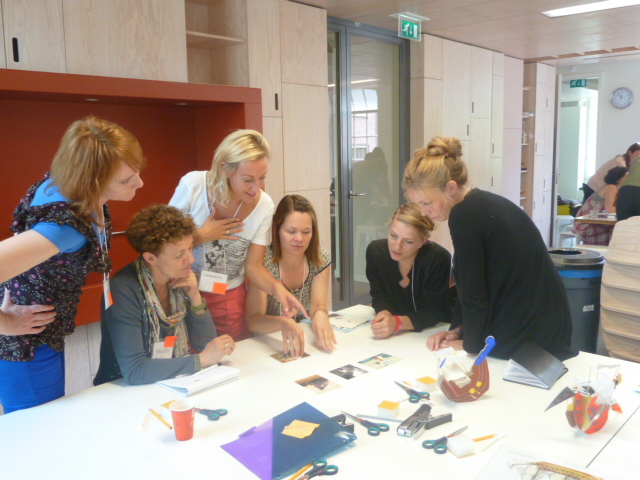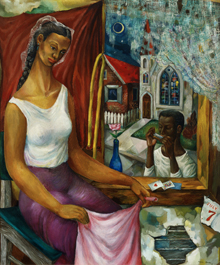This content has been archived. It may no longer be relevant
In June I attended a Visual Thinking Strategies or VTS Practicum in Amsterdam. Around 30 participants gathered together to start the 3 day course at the Reade Centre from a variety of disciplines – teachers, museum educators, psychologists, therapists and many others. I was interested to see how VTS varied in practice from Visible Thinking and whether I could use VTS within my work in museums and schools.
The mornings were run by VTS trainer Amy Chase Gulden who gave us an overview of how and why VTS was started by museum educator Philip Yenawine and cognitive psychologist Amy Housen, before describing the fundamental principles:
1. VTS is a discussion-based teaching and learning strategy and also a curriculum and professional development programme for schools ages 4-14(Visual Thinking Curriculum) involving sequenced works of art.
2. VTS uses art to develop observational skills, visual literacy, critical thinking skills and communication skills.
3. Growth is stimulated by using increasingly complex art, responding to development-based questions, participation in carefully facilitate group discussions, hearing divergent views.
The mornings were very thorough and covered a lot of ground. As a group, we discussed everything fully. On the second and third mornings we moved on from understanding the basics to learning about Abigail Housen’s aesthetic development research. We also had plenty of time to develop our paraphrasing abilities and to discuss image selection for different groups. This was particularly useful for me in the work that I do – I often spend a large amount of time looking for suitable images and objects to use with different routines.
Our first VTS discussion was centred around this painting:
After having quietly looking for a few moments, the facilitator asked the question: ‘What’s going on in this picture?’ A group discussion of about 20 minutes followed, where the facilitator paraphrased what every participant said and asked for evidence where necessary with ‘What do you see that makes you say that?’ It is important to note that neither the name of the artist nor the title of the work are revealed during the discussion (although we asked afterwards as we were extremely curious!).
The afternoons were devoted to practising the method in museums – in the Amsterdam Museum, the Stedelijk and the Hermitage Amsterdam. We were split into three groups and in our groups everyone chose a work of art to facilitate a discussion with the group. Seeing as this method differs from Visible Thinking in many ways (for more discussion between the two methods, see here), at first I found it difficult to stick to the exact wording of the three questions and to remember to ask for more evidence ( ‘What do you see that makes you say that?’). I also found it hard to paraphrase ( I felt at first as if I was just repeating everything the group said, rather than re-phrasing the information in an eloquent way), and to keep my neutrality when a participant mentioned something in the painting that I liked or agreed with. The hardest part for me is not adding any contextual information at the end of the discussion – I am so used to doing this when I work with Visible Thinking routines, so it did feel strange to me to leave the discussion without any summary or final conclusions. I also feel that at certain points in the discussion participants do need new information to get to the new level. However, my experience at the Praticum has shown that not giving out contextual information does give the participants the chance to find out information for themselves if they are curious (and for the most part, we were curious to find out more). In this way, the participant is in charge of their own learning.
The three days were very illuminating – I had presumed that the method was easy to pick up but I found it does require a large amount of practise to be able to stick to the questions exactly, paraphrase and keep neutral. The facilitators make it look so easy and natural, but it does require mental effort! The training actually made me realise that although I aim to be neutral with my usual groups, compared to VTS facilitators, I am not always! This is something I really would like to work on, as I believe a neutral facilitator is important to make the discussion fair and for everyone in the group to feel that they can contribute. In tours since, I have more been aware of moments when I would like to jump in and congratulate someone on something they said and have therefore been able to curb my natural enthusiasm.
I really enjoyed the Amsterdam Praticum and met many new friends and like-minded people. I enjoyed trying out a new method of working with groups – although VTS is essentially the original thinking routine, it is a more structured way of working to what I am used to. I intend to keep practising VTS with some of the other participants from the course and to use it selectively in my work with groups young and old. I also have a few ideas for great classroom VTS workshops too and I’m working on these for the next academic year!


Pingback: New Visual Thinking Strategies Course in Amsterdam | thinking museum